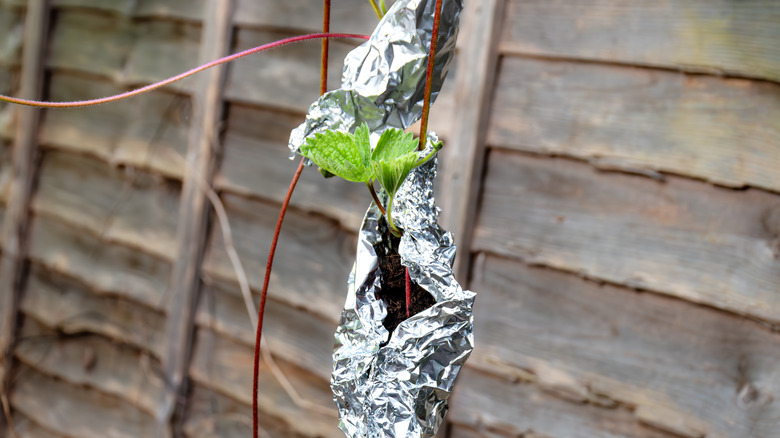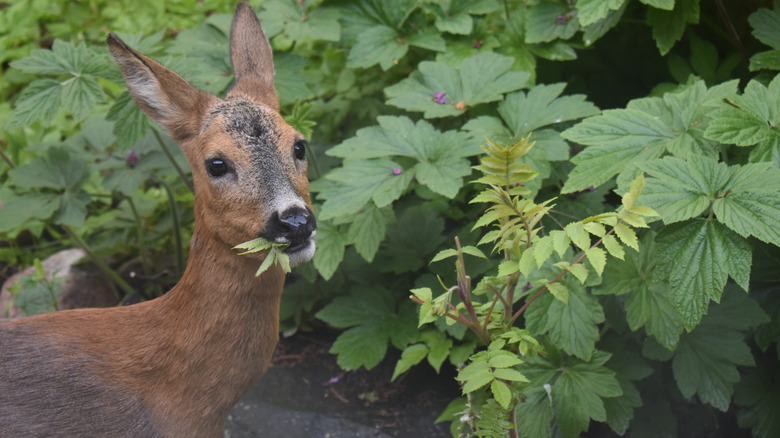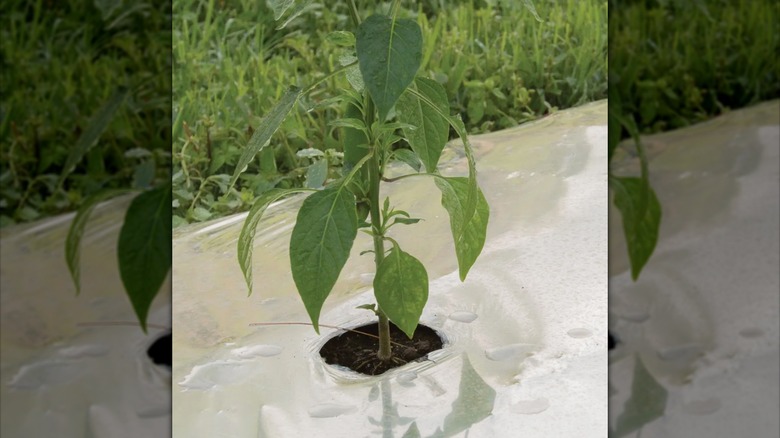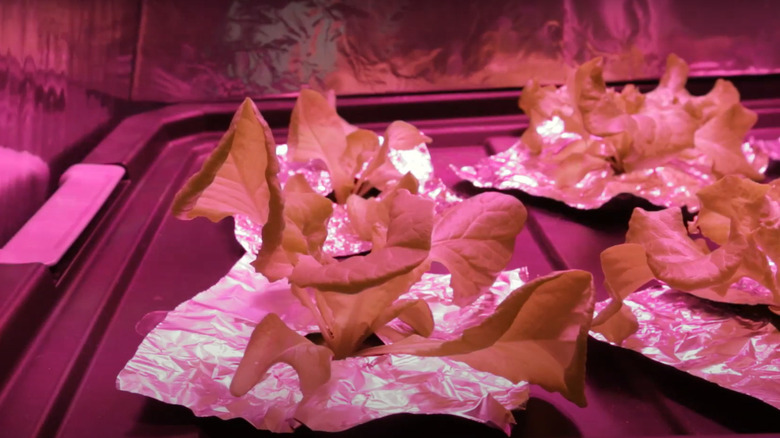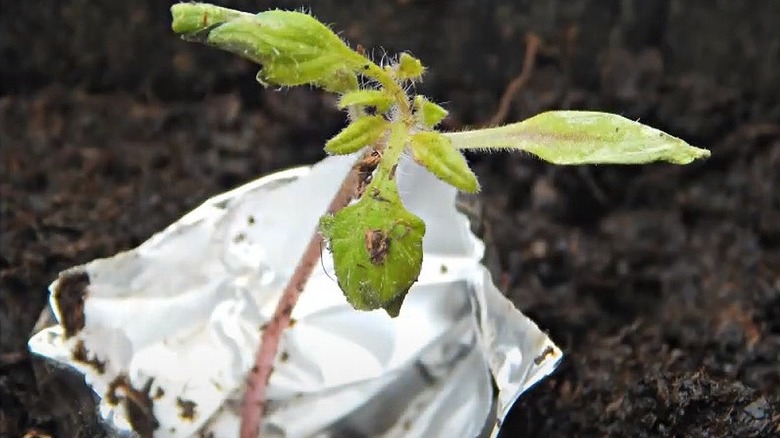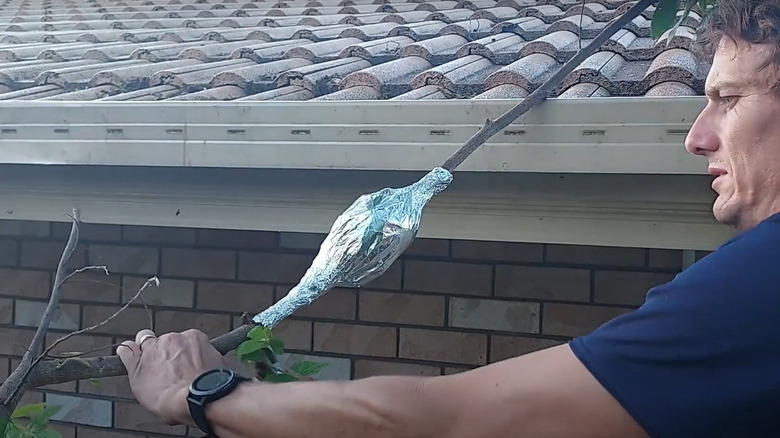Clever Ways To Use Aluminum Foil In The Garden
A beloved kitchen item used for lining baking trays and wrapping picnic food, aluminum foil has broken boundaries to foray into gardening practices. You're probably familiar with the sight of foil strips blowing chaotically in the wind to prevent birds from munching on garden fruit. Regrettably, the beaked creatures often catch on to the trickery and soon discover that the perceived threat isn't actually dangerous to them. While it's not likely to work against birds for long, this product can be used to put an end to deer browsing, eliminate garden insects, stimulate seedling growth, and propagate plants. It's true, aluminum foil can be used in a number of ways in the garden, and we've named five genius ideas below.
The best part? You don't have to bring a new roll of this product whenever you enter your garden. Simply wash any used foil pieces, flatten them, and save them for later use, living up to your eco-conscious sensibilities. However, stick to heavy-duty foil, as it's most likely to stand the test of time.
Keep deer out
Quick to run except when there's food, deer are the bane of many gardeners. Evergreens like pines and arborvitae are their favorites, although they happily munch on any type of edible food, especially when resources fall short during the winter. Naturally, protecting your garden plants from deer becomes crucial. One way to do this is to place aluminum foil around your desired plants up to the animal's feeding height, or about 2 to 3 feet above the ground. Its texture, reflectivity, and scrunching sound should temporarily scare the deer when they put their mouth where it doesn't belong. As a bonus, it could scare off rabbits, rodents, and voles as well.
That being said, its effect is short-lived, since the famished animals will eventually catch on to the fact that the tinfoil poses no major threat. Also, the metal covering can't be used in the spring or it'll interfere with the vegetative growth. If you want a fool-proof method to lend your yard year-long deer resistance, fence the area with polytape or electric wire. Follow up by splitting the aluminum foil into several pieces and wrapping them around the wire at 3 to 4-foot intervals. Glaze the foil with peanut butter to bait the deer into approaching the fence. The electric shock paired with the light reflection will give the antlered creatures a fright, keeping them away.
Create reflective mulch
Although reflective mulch doesn't decompose like organic mulch, it remains unmatched in the fight against winged pests. Leveraging its inherent nature, reflective mulch befuddles pesky invaders by reflecting back UV light instead of the blue-green light usually associated with plants. This prevents the flying insects from locating and contaminating the flora with viruses. Normally made using silver polyethylene, reflective mulch can be prepared using aluminum foil as well. Indeed, a 2003 study published by HortTechnology said that this material and others like it could repel aphids and thrips.
Since seedlings and young plants are most susceptible to diseases, protecting them with reflective mulch is a good call. Plus, they'll benefit from improved and uniformly-distributed moisture, better light (due to reflection), and warmer soils at night. To do so, clear the ground of weeds, lay down a few pieces of cardboard, and cover them with aluminum foil. Next, make 3 to 4-inch-wide cuts in the mulch to root the transplants. Remember to use a thick foil since it's less likely to disintegrate and is easier to remove once the growth season ends or when the plants grow too big for it. Also, add irrigation to the ground so your plants don't lack water — sprinklers won't be effective with this mulch. Remove the foil in peak summer to prevent scalding.
Amplify plant light
Plants desire light to display healthy growth, but providing the right amount can be difficult if you grow sun-loving shrubs in a shaded garden. To solve this issue, place aluminum foil strips around your plants to bounce the sunlight back to them. As foil reflects over 86% of visible light, the pieces should be kept at a distance to prevent sunscald. Browning leaf edges are usually a sign to move the metal pieces back. The material's reflective quality also bears fruit for containers placed in poorly-lit windows or on patios. Another advantage? Aluminum foil mirrors snails, slugs, and other pests roaming on the leafy undersides, making picking them off a breeze.
You can also use aluminum foil to grow your seedlings before transplanting them into the yard. Either hang the metal strips from the grow lights or line the trays with foil to boost sunlight. Alternatively, place the foil around the plants after turning it into reflector trays — just keep it near your cold frame's edges. Having light from all corners will keep the seedlings robust instead of straggly when they're leaning in the sun or grow light's direction. You can even DIY starter pots by splitting the foil's cardboard tube into 3-inch-long sections and casing them with aluminum foil to hold the pots together. Then, add in seeds and watch them grow. Once ready to transplant into the garden, simply remove the foil and plant them in the decomposable cardboard.
Drive out cutworms
Cutworms — the larvae of night-flying moths — are a scourge to deal with. Generally nocturnal, these juveniles begin at the roots and find their way up, cleanly cutting off the plant stems at the soil level. They mostly target newly-transplanted seedlings, especially beans, peas, tomatoes, carrots, potatoes, and peppers, since their immature stalks are easier to slice through. Although you can treat them with organic pesticides, they aren't always effective. In contrast, aluminum foil presents a different story.
The easiest way to send cutworms packing is to inhibit their access to the plants, and aluminum foil helps achieve that. Simply cut 2 to 3-inch-long aluminum strips and wrap them around the saplings as a collar. Drive the pieces deep into the substrate to prevent the larvae from using the underground pathways to munch on stems. Use the opportunity to hand-pick and dispose of the collected swarm as well. Remove the foil once the problem abates post-spring. Simultaneously, consider dust mulching, a method where the first inch of the topsoil is tilled to keep it dry while the remaining layers remain moist. This should eliminate cutworms, as they use damp organic mulches for shelter. Placing aluminum foil collars can also remove squash vine borers and keep southern blight fungus at bay.
Layer new plants
While it's common to propagate new plants using seeds or cuttings, some varieties perform better with layering, and aluminum foil improves the process. Layering involves cutting or bending and inserting the parent plant's stem into the substrate to encourage the sprouting of adventitious roots. Afterward, the daughter plant is separated from the main plant and transplanted to a different area. Blackberries, pothos, rhododendrons, rubber trees, and honeysuckles are often asexually propagated using layering.
Aluminum foil comes into the picture after the parent plant has already been wounded and plastic-wrapped, ready for implanting into the soil. This is followed by wrapping the bent stem in metallic foil and covering it completely with the substrate. Or, if you're air layering, you'd wrap the cut in soil and then use the foil to create a ball around the plant to keep it attached to the soil as it grows. As aluminum doesn't absorb light or heat and instead redirects most of it back, this bodes well for root formation, since roots grow out swiftly once their light access is blocked. This way, you can ensure better success with layering and enjoy a new plant at no extra cost.
